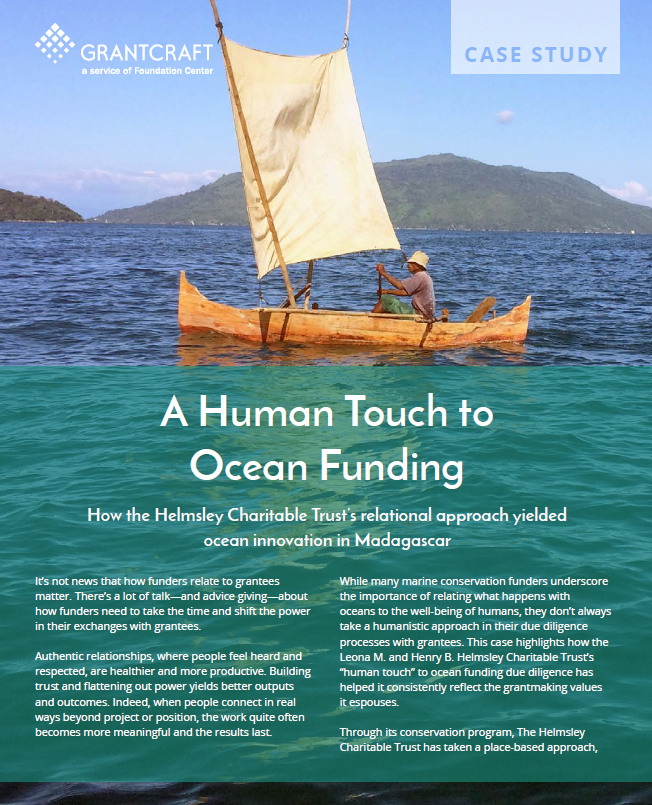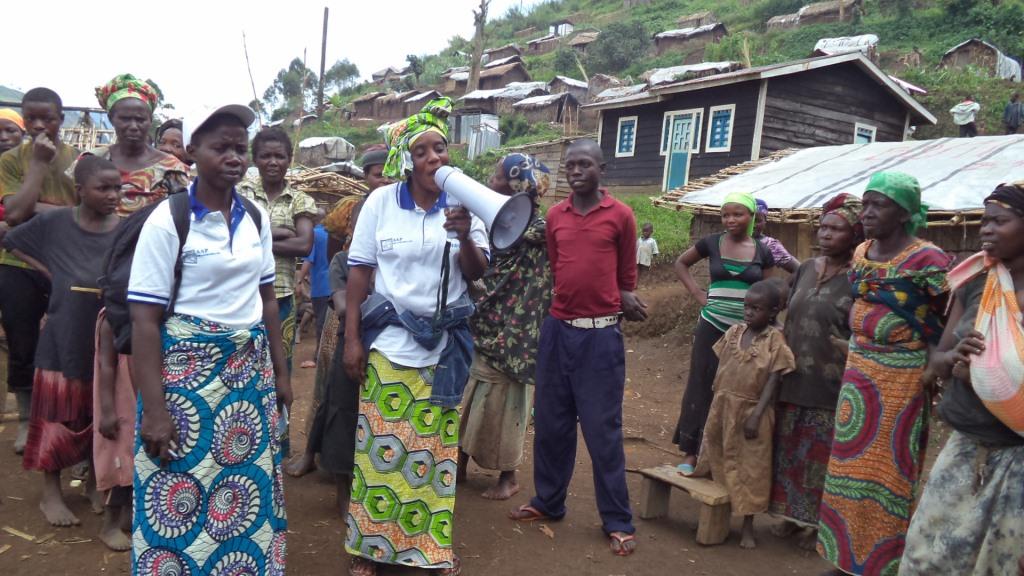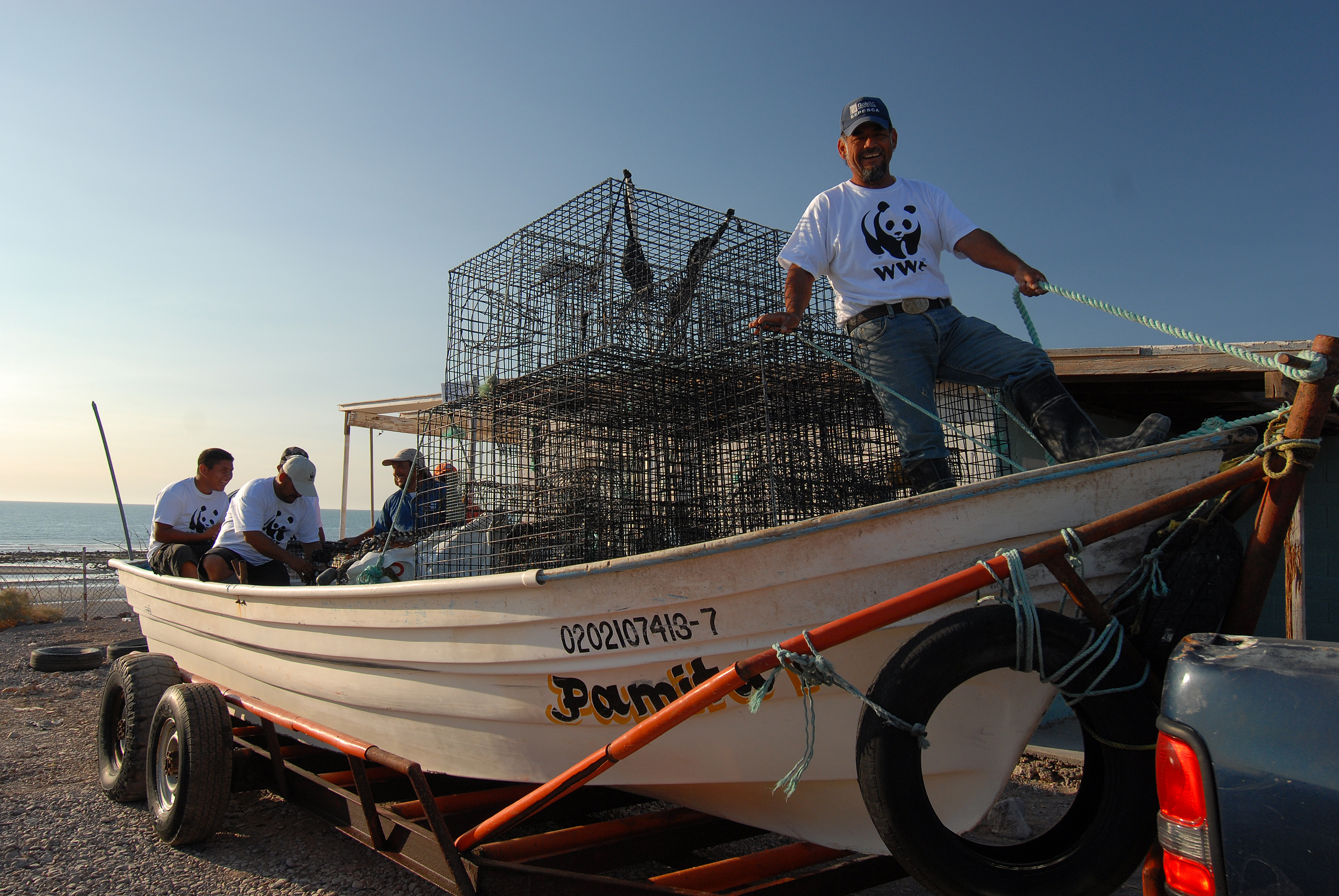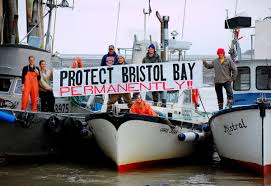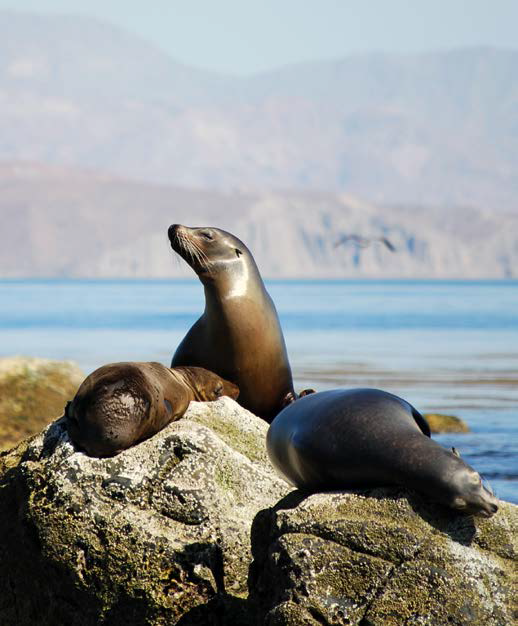A Human Touch to Ocean Funding How the Helmsley Charitable Trust’s relational approach yielded ocean innovation in Madagascar
It’s not news that how funders relate to grantees matter. There’s a lot of talk – and advice giving – about how funders need to take the time and shift the power in their exchanges with grantees.
Authentic relationships, where people feel heard and respected, are healthier and more productive. Building trust and flattening out power yields better outputs and outcomes. Indeed, when people connect in real ways beyond project or position, the work quite often becomes more meaningful and the results last.
While many marine conservation funders underscore the importance of relating what happens with oceans to the well-being of humans, they don’t always take a humanistic approach in their due diligence processes with grantees. This case highlights how the Leona M. and Henry B. Helmsley Charitable Trust’s “human touch” to ocean funding due diligence has helped it consistently reflect the grantmaking values it espouses.
Through its conservation program, The Helmsley Charitable Trust has taken a place-based approach, funding areas of the world like Madagascar, where habitat and human interests struggle to harmoniously co-exist. Helmsley’s website describes a collaborative way of working “with outstanding global and local organizations to resolve environmental threats in ways that ensure the well-being of local communities while sustaining natural resources and biodiversity.”
According to Alasdair Harris, executive director of Blue Ventures, an international conservation organization that rebuilds tropical fisheries with coastal communities via transformative, locally-led approaches, the foundation has consistently operated in this fashion.
It all starts with Helmsley’s due diligence approach, which Alasdair characterizes as different from other foundations. “Helmsley’s early due diligence and interaction with us was strongly relational,” says Alasdair. “When they launched their work in Madagascar, they held face-to-face consultations with organizations in-country. They didn’t just meet with the international NGOs or let the larger players sit at the table. They also brought field-based, national organizations into the conversation.” For Helmsley’s staff and board, understanding the complex socio economic and environmental issues in the geographic places it funds is important early on in grantmaking. That means consulting with groups big and small. In Madagascar: “we were getting our feet wet and needed to get a handle on what approaches worked and why and what didn’t work,” says Renu Saini, a conservation program officer at Helmsley. “It would be shortsighted not to understand all the players working in our geographies.”
For Alasdair, bringing a broader group of organizations to the table sent an important message. “How a funder first starts interacting with organizations when developing a new grant portfolio is critical. Helmsley took the time to engage with local civil society beyond the big international NGOs – which was fundamental to them getting a broader perspective on the sector. If you’re gathering all your data in London or Washington, D.C., how on earth can you find the groups who may be working under the radar and who so often get eclipsed by the marketing might of the large international NGOs?”
Helmsley’s in-country due diligence didn’t stop with a one-off consultation. Foundation staff and board members have continued to keep in close contact with grantees, visiting Madagascar frequently. “We have visited 3-5 field sites a year,” says Renu. “This allowed us to understand the work on the ground and strengthen our relationships with grantee partners.” Other meetings included grantee workshops to encourage sharing and coordination on regional conservation, and one on one meetings with individual grantees, some including Helmsley’s grants management team. “Grantees could sit with a Helmsley grants manager to discuss any challenges they were having and use our internal staff expertise as a resource for anything from developing budgets to questions about their bylaws.” Beyond discussing conservation, Helmsley dedicated time to celebrate and thank its partners for their work. For example, it held a reception dinner to which grantees, alongside government leaders, multilaterals, and other funding partners were invited. According to Alasdair, Helmsley’s time in-country connecting deeply with multiple constituencies helped the foundation become more focused and strategic. “This increased their awareness of the complexity of the sites in which they were investing,” says Alasdair. “It helped them recognize there’s no silver bullet, and they became more interested in exploring entrepreneurial and integrated interventions.”
One such integrated intervention is a community health program that Blue Ventures started and to which Helmsley provided core support. Today, Blue Ventures provides weekly maternal, reproductive, and child health services to more than 30,000 women and children in Madagascar’s underserved areas in the vicinity of the organization’s existing environmental conservation programs. Some might consider this unusual for a marine conservation foundation to fund, not to mention a marine conservation NGO, to embark upon. But ever since local women shared their needs and Blue Ventures responded by opening a clinic in 2007, the connection to conservation has been very clear. “Giving women access to reproductive health and family planning services enables them to become more engaged in issues that impact their communities,” says Alasdair. “Women now represent a major constituency within Madagascar's Locally Managed Marine Areas (LMMAs), for instance – which wasn’t the case when we supported communities to establish Madagascar’s first LMMA a decade ago.”
Blue Ventures and Helmsley have seen how the community health work has helped coastal families, and by extension, coastal communities, become better equipped to live in healthy and sustainable ways with their marine environment. “It’s all part of Blue Ventures’ holistic community-based approach,” says Renu. “It addresses the very real issues that can get in the way of conservation for local people. They take an integrated approach that helps people see the links between things like having big families and food security, financial stability, and overfishing that ultimately harms them.” According to recent census data, fertility patterns have changed. While difficult to attribute solely to Blue Ventures, the fertility rate in Madagascar has dropped a third.
Helmsley’s staff recognize the uniqueness of supporting health programming through its conservation portfolio. “Our foundation peers have applauded us for integrating the human piece,” says Renu. “We have approached things very holistically and tested ideas out.” Being a younger organization may have helped the foundation approach its grantmaking more flexibly. However, Alasdair notes the underlying relational link that helped make Blue Ventures’ health program possible. “Helmsley was enlightened in its approach, and remained sufficiently informed of the reality of the situation in Madagascar to embrace the relationship between population, health and the environment. Most donors we speak to will not consider venturing beyond restricted funding disciplines, let alone explore integrated programming. In most cases, we would rarely consider approaching a U.S. family foundation that’s funding conservation to give us support to uphold reproductive rights. It was different with Helmsley, though.” Renu too notes ongoing dialogue as the root of healthy funder-grantee relationships. “Especially in small places like Madagascar, it’s always important to talk with people on the ground and be open to different ideas.”
Helmsley’s trust-based approach clearly helped it “go wide,” integrating conservation with other issues, but it also deepened its ocean conservation approach with grantees. One example has been supporting Blue Ventures’ first-of-its-kind research effort into the carbon dynamics of mangroves. “This might have been seen as risky, especially given the uncertainty in carbon markets” says Alasdair. “But because of the foundation of trust Helmsley had built, they listened to us and invested in the design of our mangrove carbon program – one of the world’s first blue carbon projects.”
Sometimes Helmsley’s relational approach has focused less on the programmatic and more on administrative aspects of the funder-grantee relationship. “We have many conversations with conservation grantees about right-sized grants,” says Renu. “Sometimes that has meant making adjustments to grant parameters, including timelines. We try to approach the issue of ‘right-sizing’ as a topic of mutual interest. We communicate that we want to make sure we don’t come in too big. Everyone knows that can leave a mess behind.” For example, the first Blue Ventures grant timeline got extended by six months when Blue Ventures needed more time to accomplish the grant objectives. Since then, Helmsley has worked with Blue Ventures and other Madagascar grantees to align funding amounts and time periods with grant objectives. “This has helped cut down on grantees feeling pressed to take on more than they can handle,” says Renu.
Helmsley’s staff not only works closely with individual grantees, but they also encourage grantees across the conservation portfolio to work with one another. “Helmsley shared with us grantee addresses and project titles,” says Alasdair. “And then the foundation created a pot of money that we could apply to for collaborative inter-regional initiatives with other grantees, such as learning exchanges.” While some might argue programs like these benefit more from an open exchange beyond the limitations of one foundation’s pool of grantees, Alasdair notes the upside of these types of connections. “Because of this opportunity, people from Madagascar went to Mexico for the first time. They shared experiences. And our fishery management model was replicated in Mexico. They even enabled us to make a film about the experience.” By bringing grantees together in these ways, foundations like Helmsley can multiply their impact, generating common knowledge and scaling what works.
At its core, Helmsley’s investment in the relationship building aspect of due diligence isn’t just a nice thing to do. Grantees also see it as a smart way to ensure better local outcomes. “Helmsley’s investment in face-to-face engagement and human relationships not only made us feel valued and listened to, but also taught us that if we ever venture into grant making as an organization, it will be essential for us to invest time and resources in rigorous boots-on-the-ground due diligence,” says Alasdair. “Helmsley demonstrated a far more balanced ratio of due diligence to investment than many funders that we hear of. They visited the field regularly, meeting with grantees and taking a strong interest in our work and our team. That insight proved fundamental in helping them allocate their resources judiciously. From my experience of other foundations supporting conservation and rural development in Madagascar and other tropical coastal developing states, few donors visit more than once every few years – at best – and when they do, they can rarely afford the time to reach the field.”
For Alasdair, that’s perhaps unsurprising in a context like Madagascar where it can take more than one week of driving off road in arduous conditions to access some sites. But he believes the inevitable result of this lack of scrutiny is that fundraising becomes a matter of marketing and salesmanship undertaken in capital cities – rather than of demonstrating actual impact and behavior change on the ground. “‘Smoke and mirrors’ projects will often continue to attract the lion’s share of support – initiatives where reality is far removed from the hype,” says Alasdair. “It astounds us why funders so rarely invest the time to see what’s really going on, perpetuating these inefficiencies and the disconnect between funding and impact that is so striking in our sector.”
Helmsley has announced that it plans to shift from its conversation focus, with the plan to roll out new opportunities in 2018. With leadership transitions come new approaches that can not only change the work, but the underlying culture of practice. As Helmsley winds down its current conservation focus efforts and embarks in new directions, it plans to hold on to the “human touch” that has so clearly set its marine conservation work apart.
This case study was developed as a companion piece to stories shared through Foundation Center’s Funding the Ocean project. Funding the Ocean is a dynamic hub to inform and inspire ocean conservation philanthropy around the world. It includes a mapping application, repository of reports and case studies, and a cloud-based platform for engagement.
